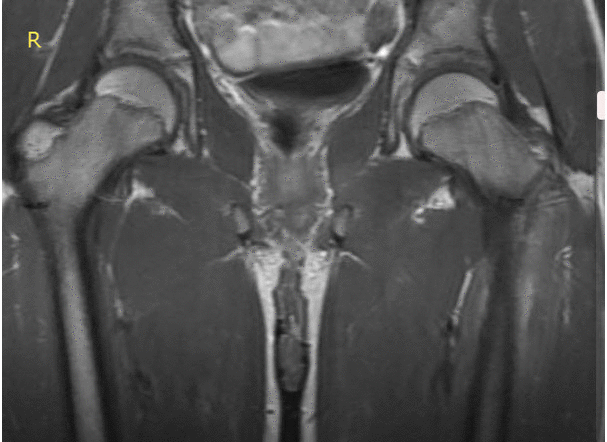Osteomyelitis MRI
Jump to navigation
Jump to search
|
Osteomyelitis Microchapters |
|
Diagnosis |
|---|
|
Treatment |
|
Case Studies |
|
Osteomyelitis MRI On the Web |
|
American Roentgen Ray Society Images of Osteomyelitis MRI |
Editor-In-Chief: C. Michael Gibson, M.S., M.D. [1]; Associate Editor(s)-in-Chief: Seyedmahdi Pahlavani, M.D. [2]
Overview
MRI is the accepted modality of choice for the early detection and surgical localization of osteomyelitis.
MRI
- MRI is more sensitive than CT or radionuclide imaging in acute osteomyelitis and is the best radiographic imaging technique for identifying abscesses and for differentiating between bone and soft tissue infection.[1]
- MRI provides precise anatomic detail of subperiosteal pus and accumulation of purulent debris in the bone marrow and metaphysis, for possible surgical intervention. In acute osteomyelitis, purulent debris and edema appear dark, with decreased signal intensity on T1- weighted images, while fat appear bright.[2]
- In T2 weighted images, the signal from fat is diminished with fat suppression techniques to enhance visualizaton.
- Gadolinium administration can enhance MRI resolution and increase the diagnostic yield.
- Gadolinium becomes localized in areas of increased vascularity and blood flow and also helps distinguish soft tissue infections such as abscesses and cellulitis from osteomyelitis.
- Cellulitis and sinus tracts appear as areas of high signal intensity on T2-weighted images.[3]
- Osteomyelitis produces a diminished intensity of the normal marrow signal on T1-weighted images and a normal or increased signal on T2-weighted images.[4]
MRI with fat suppression T2-weighted

T1 MRI with Gadolinium

References
- ↑ Pineda C, Vargas A, Rodríguez AV (2006). "Imaging of osteomyelitis: current concepts". Infect. Dis. Clin. North Am. 20 (4): 789–825. doi:10.1016/j.idc.2006.09.009. PMID 17118291.
- ↑ Averill LW, Hernandez A, Gonzalez L, Peña AH, Jaramillo D (2009). "Diagnosis of osteomyelitis in children: utility of fat-suppressed contrast-enhanced MRI". AJR Am J Roentgenol. 192 (5): 1232–8. doi:10.2214/AJR.07.3400. PMID 19380545.
- ↑ Copley LA (2009). "Pediatric musculoskeletal infection: trends and antibiotic recommendations". J Am Acad Orthop Surg. 17 (10): 618–26. PMID 19794219.
- ↑ Lalam RK, Cassar-Pullicino VN, Tins BJ (2007). "Magnetic resonance imaging of appendicular musculoskeletal infection". Top Magn Reson Imaging. 18 (3): 177–91. doi:10.1097/RMR.0b0318123eee56. PMID 17762382.